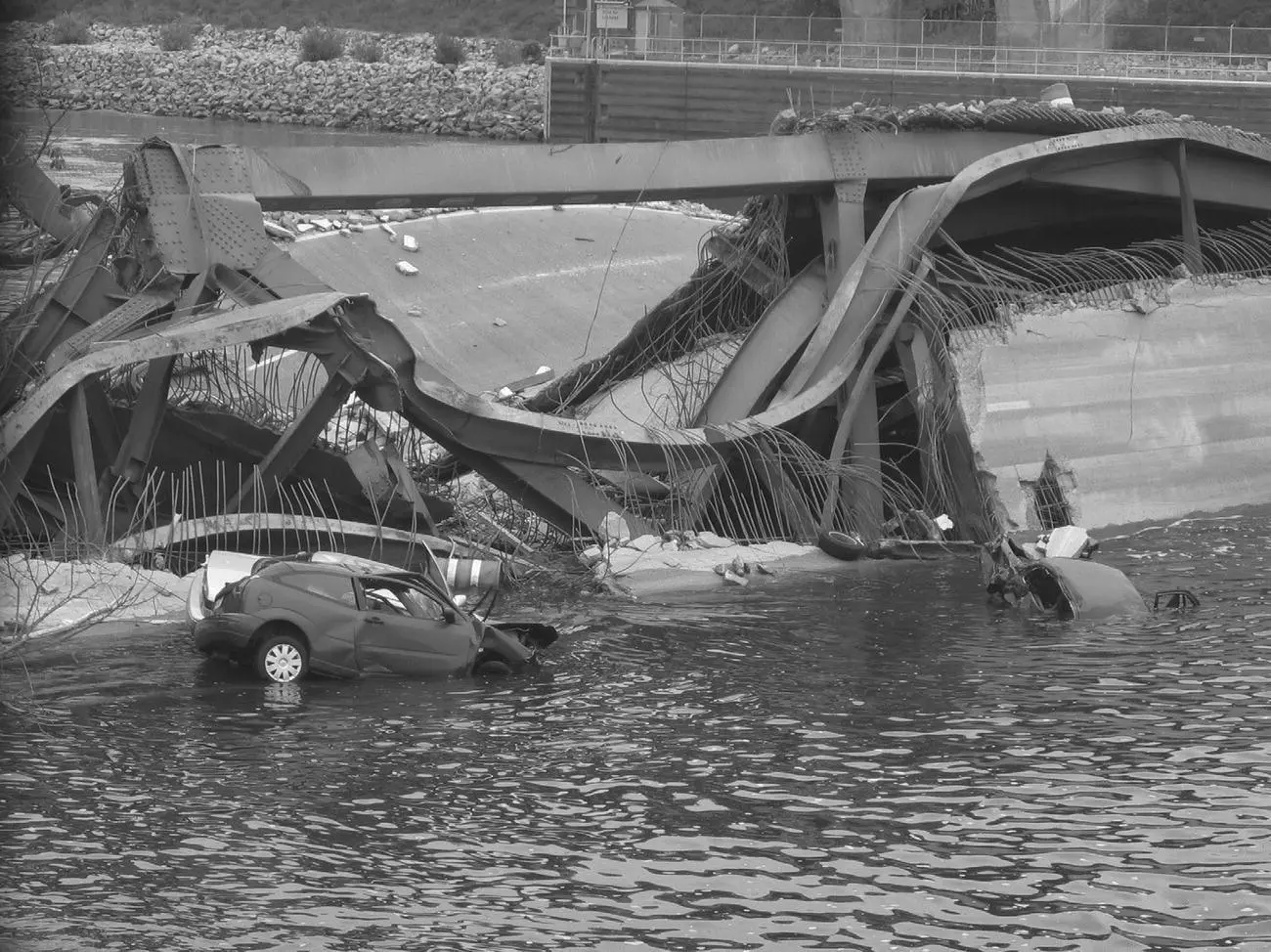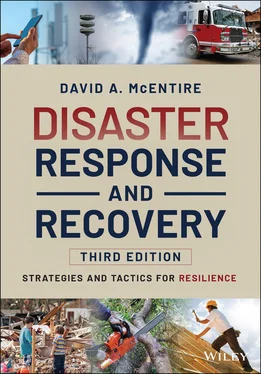David A. McEntire - Disaster Response and Recovery
Здесь есть возможность читать онлайн «David A. McEntire - Disaster Response and Recovery» — ознакомительный отрывок электронной книги совершенно бесплатно, а после прочтения отрывка купить полную версию. В некоторых случаях можно слушать аудио, скачать через торрент в формате fb2 и присутствует краткое содержание. Жанр: unrecognised, на английском языке. Описание произведения, (предисловие) а так же отзывы посетителей доступны на портале библиотеки ЛибКат.
- Название:Disaster Response and Recovery
- Автор:
- Жанр:
- Год:неизвестен
- ISBN:нет данных
- Рейтинг книги:5 / 5. Голосов: 1
-
Избранное:Добавить в избранное
- Отзывы:
-
Ваша оценка:
- 100
- 1
- 2
- 3
- 4
- 5
Disaster Response and Recovery: краткое содержание, описание и аннотация
Предлагаем к чтению аннотацию, описание, краткое содержание или предисловие (зависит от того, что написал сам автор книги «Disaster Response and Recovery»). Если вы не нашли необходимую информацию о книге — напишите в комментариях, мы постараемся отыскать её.
The new edition of the standard textbook in the field, updated with new studies and practical guidelines for reacting to the complexities of today’s disasters Disaster Response and Recovery: Strategies and Tactics for Resilience
Disaster Response and Recovery: Strategies and Tactics for Resilience, Third Edition
Disaster Response and Recovery — читать онлайн ознакомительный отрывок
Ниже представлен текст книги, разбитый по страницам. Система сохранения места последней прочитанной страницы, позволяет с удобством читать онлайн бесплатно книгу «Disaster Response and Recovery», без необходимости каждый раз заново искать на чём Вы остановились. Поставьте закладку, и сможете в любой момент перейти на страницу, на которой закончили чтение.
Интервал:
Закладка:
As mentioned earlier in this chapter, the Fukushima disaster was a significant event that involved a nuclear power plant in central Japan in 2011. The damages caused by a prior earthquake and tsunami resulted in a power failure and flooding of the reactors. The loss of generators and circulating pumps created a nuclear meltdown and hydrogen explosion. A fear of the unfolding radiation leak necessitated the evacuation of 154,000 people. Workers were able to resolve the issue, but only after 2 employees died and 20 others were injured and exposed to dangerous radiation levels. This event illustrated the inherent dangers of industrial hazards.
1.3.4 Structural Fire Hazards
Fires that impact buildings and homes may also be labeled as technological hazards. These fires result from smoking, cooking, and carelessness with fireplaces. Others are caused by arsonists. Besides decimating structures, these events can kill scores or hundreds of people. The disturbing list of such fires throughout history includes the Richmond Theater Fire in 1811, the Triangle Shirtwaist Factor fire in 1911, the Coconut Grove fire in 1942, the Mercy Hospital Fire in 1950, the Warrenton Nursing Home fire in 1957, the Golden Age Nursing Home fire in 1963, the Sennichi Department Store fire in 1972, the Beverly Hills Supper Club fire in 1977, the Dupont Plaza Hotel fire in 1986, the Happy Land fire in 1990, the Dabwali fire in 1995, and the Ycua Bolanos Supermarket fire in 2004. Other fires have resulted from the improper use of fireworks such as the Mesa Redonda fire in 2001, the Lame Horse fire in 2009, the Puttingal temple fire in 2016, the San Pablito market fire in 2016, the Tultepec explosion in 2018, and the Ontario explosion in 2021. Notable fires have also occurred for various reasons at the National Museum of Brazil fire in 2018 and the Notre Dame fire in 2019.
While many of these fires are accidental or intentional, others result from improper wiring of equipment or facilities. A conspicuous example is the MGM Hotel fire in Las Vegas, Nevada, that occurred on 21 November 1980. The electrical connection for a pastry display case sparked due to a faulty ground connection. Wire connections lacked plastic insulation and the vibration from the fan caused the bare electrical conductors to arch. The combustible material in the seats and other materials in the restaurant caused quick acceleration of burning. No sprinkler suppression systems were installed in this part of the hotel and many of the fire escape doors were locked. Smoke quickly filled the building through the ventilation system. Eighty‐five people died and another 650 were injured. Poisoning from carbon monoxide on upper floors were the main cause of death, which prompted a major investigation. Code changes were implemented in Nevada and the reconstruction of the MGM in 1981 included additional sprinkler systems, a speaker system for warning, and a new air‐conditioning system.
1.3.5 Structural Collapse Hazards
The collapse of structures is another potentially deadly hazard. Structural collapsesare hazards that occur when gravity and poor engineering interact and result in the failure of buildings, roads or other construction projects. These collapses may include the breaking of dams and dykes or the crashing down of buildings. As an example, there have been numerous dam failures throughout the history of the United States, including those in Johnstown, Pennsylvania (1889); Buffalo Creek, West Virginia (1972); and Teton, Idaho (1976). The failure of dikes and retaining devices also occurred in the 1993 Midwest floods and after Hurricane Katrina in New Orleans. Thousands of lives, considerable property and large amounts of infrastructure have been lost due to such hazards.
Structural failures are not limited to water retaining devices alone, however. Buildings, parking garages and bridges have also suffered from problematic engineering, inadequate construction and improper use. For instance, poor design, insufficient steel reinforcement, and an improper mix of concrete resulted in a building collapse in Kuala Lumpur in 1968 (Aini et al., 2005). The event killed 7 people and injured 11 others. But, this collapse was minimal as compared to others that have occurred. In 1995, the Sampoong Department Store collapsed in Seoul, Korea. This structure was built quickly during a construction spree prior to the 1988 Summer Olympics. The mall was located on an existing landfill and lacked sufficient support columns and crossbeams. Warning signs (i.e., cracks in the structure) became visible and experts noted that the building was at risk of collapse. A leader of Sampoong refused to request an evacuation. The collapse occurred a short time later. It killed 502 people and injured over 900 more.
Two notable structural failures in the United States include the 1981 Hyatt Skywalk collapse and the 2021 Surfside condominium collapse. While a dance was held in the Hyatt hotel atrium, a suspended walkway broke loose from and this killed over 100 people as it fell to the floor. In spite of concerns raised about land subsidence and cracks in support columns, no renovations were made at the Surfside Condominium. 98 people died when a portion of the 12‐story building crashed to the ground. Sadly, these collapses occur when construction is not taken seriously.
Another structural failure occurred in August 2007 over the Mississippi River near Minneapolis. During rush hour traffic, the I‐35W bridge suddenly gave way due to what is speculated as a design flaw. The bridge and cars plummeted to the river below. Nearly 150 people were injured and 13 were killed. In May 2013, a parking structure that was under construction collapsed at Montgomery Mall in Maryland. This event left one person dead and another injured. Structural failures are often fatal, and they are very costly too ( Figure 1‐7).
In similar fashion, a pedestrian bridge at Florida International University gave way and fell to the road below. The collapse, which occurred on March 16, 2018, crushed cars and killed six individuals. After an investigation, it was determined that design errors were to blame for this failure. And, on September 12, 2020, a parking structure in Atlanta partially collapsed while it was under construction; 10 floors pancaked to the ground and resulted in a pile of concrete and a big cloud of dust. Although only one person was injured in the event, it also illustrated how serious structural collapses can be.

Figure 1‐7 The aftermath of the I‐35W bridge collapse is seen in this picture from Minneapolis, MN. Todd Swain/FEMA. http://www.fema.gov/media‐library/assets/images/51546
1.3.6 Transportation Hazards
Because of the ease of moving people, goods, and services around the world, we are faced with several transportation hazards. A transportation hazardis an accident that occurs on roads or railways, at sea or in the air. Such incidents may result from adverse meteorological circumstances, human error or mechanical failure. For example, there may be a massive vehicle accident owing to wet and wintery weather. At other times, tired or careless drivers may overturn their tankers on freeways, which carry hazardous materials and force the evacuation of neighborhoods and portions of cities. Train derailments may also occur and may result from reckless young drivers trying to beat the safety gates, animals grazing on the tracks, and the expansion or contraction of rails due to heat and freezing temperatures. Disturbing mistakes may also occur. In July 2013, the conductor of a train in Spain was talking on a cell phone and failed to slow down as necessary for an approaching curve. The wreck claimed the lives of 79 people. On April 2, 2021, Taiwan experienced its worst rail accident in seven decades. A train traveling 80 mph near the city of Hualien hit a construction vehicle that was mistakenly parked on the rails. The eight‐carriage train then derailed inside a tunnel. At least 50 people were killed, and 200 others were injured. Besides deaths, train derailments can also emit hazardous materials into the environment and create a cleanup nightmare for rail companies and surrounding communities.
Читать дальшеИнтервал:
Закладка:
Похожие книги на «Disaster Response and Recovery»
Представляем Вашему вниманию похожие книги на «Disaster Response and Recovery» списком для выбора. Мы отобрали схожую по названию и смыслу литературу в надежде предоставить читателям больше вариантов отыскать новые, интересные, ещё непрочитанные произведения.
Обсуждение, отзывы о книге «Disaster Response and Recovery» и просто собственные мнения читателей. Оставьте ваши комментарии, напишите, что Вы думаете о произведении, его смысле или главных героях. Укажите что конкретно понравилось, а что нет, и почему Вы так считаете.












